By Leen Randell
Updated: Jul 10, 2024
10 Best Herbal Decoctions For Amenorrhea
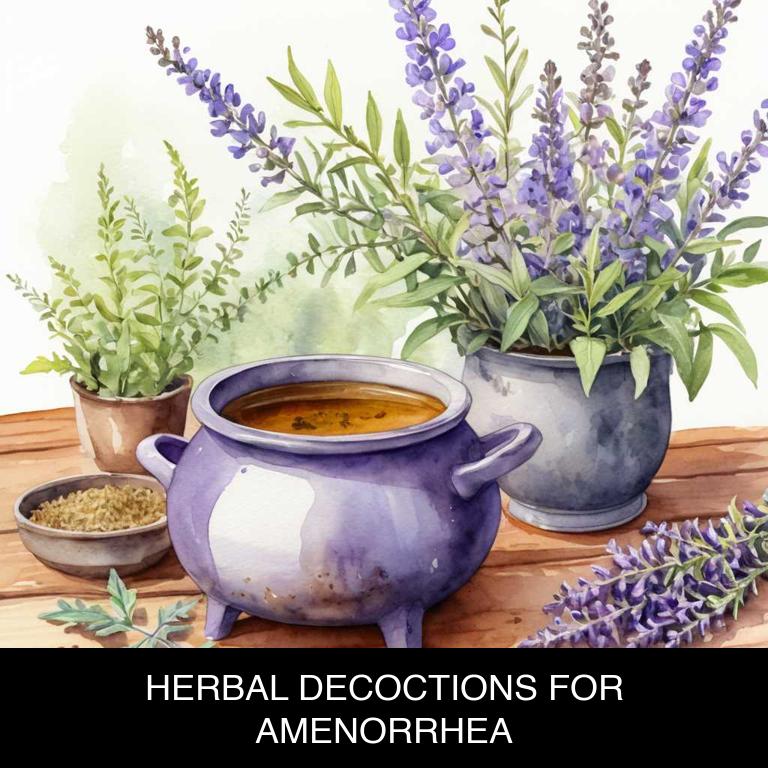
Herbal decoctions for amenorrhea are a traditional approach to treating irregular or absent menstrual cycles, using a concentrated liquid extract made by steeping herbs in hot water.
These decoctions help regulate menstruation by balancing hormones, stimulating uterine contractions, and addressing underlying conditions such as stress, fatigue, and nutrient deficiencies. Examples of herbal decoctions that help with amenorrhea include those made from raspberry leaf, ginger, and vitex, which have been shown to restore normal menstrual cycles and alleviate associated symptoms like cramping and mood swings.
By restoring regular periods, these decoctions can improve overall quality of life for women suffering from amenorrhea, reducing anxiety and increasing confidence in one's reproductive health.
The following article describes in detail the most important decoctions for amenorrhea, including medicinal properties, parts of herbs to use, and recipes for preparations.
- 1. Vitex agnus castus
- 2. Angelica archangelica
- 3. Ginkgo biloba
- 4. Dysosma pleiantha
- 5. Rubus idaeus
- 6. Cnidium monnieri
- 7. Glycyrrhiza glabra
- 8. Paeonia x suffruticosa
- 9. Agrimonia eupatoria
- 10. Taraxacum mongolicum
- What is the best combination of herbal decoctions to use for amenorrhea?
- What ailments similar to amenorrhea are treated with herbal decoctions?
1. Vitex agnus castus
Chaste tree decoctions helps with amenorrhea because they contain phytoestrogens, specifically flavonoids and phenolic acids, which help regulate hormonal imbalances that can cause menstrual irregularities.
The decoction's estrogenic properties stimulate the pituitary gland to release follicle-stimulating hormone (FSH), promoting ovulation and menstruation.
Additionally, chaste tree's anti-inflammatory and antispasmodic properties may help alleviate cramping and discomfort associated with menstrual cycles, further supporting its use in treating amenorrhea.
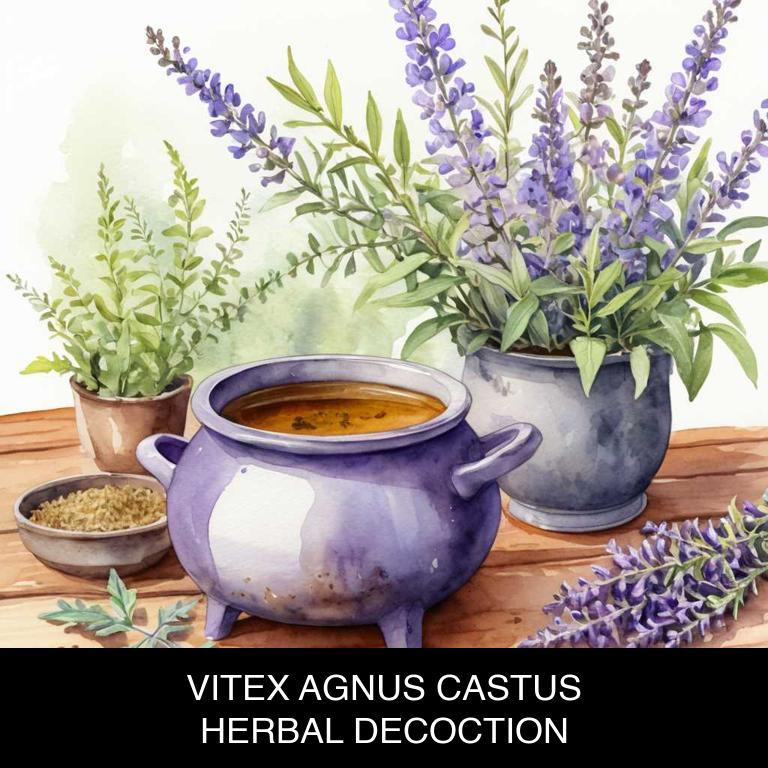
Medicinal Constituents
The list below shows the primary medicinal constituents in Vitex agnus castus decoctions that help with amenorrhea.
- Iridoid glycosides: Iridoid glycosides, particularly aucubin and agnuside, in Vitex agnus-castus help with amenorrhea by modulating the hypothalamic-pituitary-gonadal axis, thereby regulating menstrual cycles and hormone balance.
- Flavonoids: The flavonoids present in Vitex agnus-castus, such as kaempferol and quercetin, exhibit estrogenic and anti-estrogenic properties, which help to regulate menstrual cycles and alleviate symptoms of amenorrhea by influencing the body's hormonal balance.
- Diterpenes: Diterpenes, particularly agnuside and aucubin, in Vitex agnus-castus may help to regulate menstrual cycles and alleviate symptoms of amenorrhea by exerting a sedative effect on the nervous system, reducing stress, and promoting hormonal balance.
Parts Used
The list below shows the primary parts of chaste tree used to make decoctions for amenorrhea.
- Flowers: The flowers are the primary part used for decoctions to treat amenorrhea because they contain the highest concentration of iridoid glycosides, which have been shown to have a regulatory effect on the menstrual cycle.
- Leaves: The leaves are another commonly used part for decoctions due to their ability to enhance the overall effect of the flowers and provide a more sustained release of the active compounds.
- Seeds: The seeds are sometimes used in decoctions as they contain a higher concentration of ursolic acid, a compound that may help to regulate menstrual flow and alleviate symptoms of amenorrhea.
Quick Recipe
The following recipe gives a procedure to make a basic chaste tree for amenorrhea.
- Gather 20-30 grams of dried vitex agnus castus berries or 40-60 grams of fresh leaves and flowers.
- Combine the gathered herbs with 1 liter of boiling water in a heat-resistant container.
- Reduce heat to a simmer for 5-10 minutes or bring to a boil for 1-5 minutes.
- Strain the decoction through a cheesecloth or a fine-mesh sieve into a separate container.
- Discard the solids and store the decoction in the refrigerator for up to 3 days.
2. Angelica archangelica
Angelica decoctions helps with amenorrhea because of its ability to regulate hormonal balance, particularly estrogen and progesterone levels.
The plant's bioactive compounds, such as ligustilide and senkyunolide, have been shown to stimulate uterine contractions, improve blood flow, and reduce inflammation. This can help to normalize menstrual cycles, alleviate symptoms of dysmenorrhea, and even induce menstruation in individuals with amenorrhea.
Additionally, angelica's adaptogenic properties can help to calm the nervous system, reducing stress and anxiety that may contribute to irregular periods.
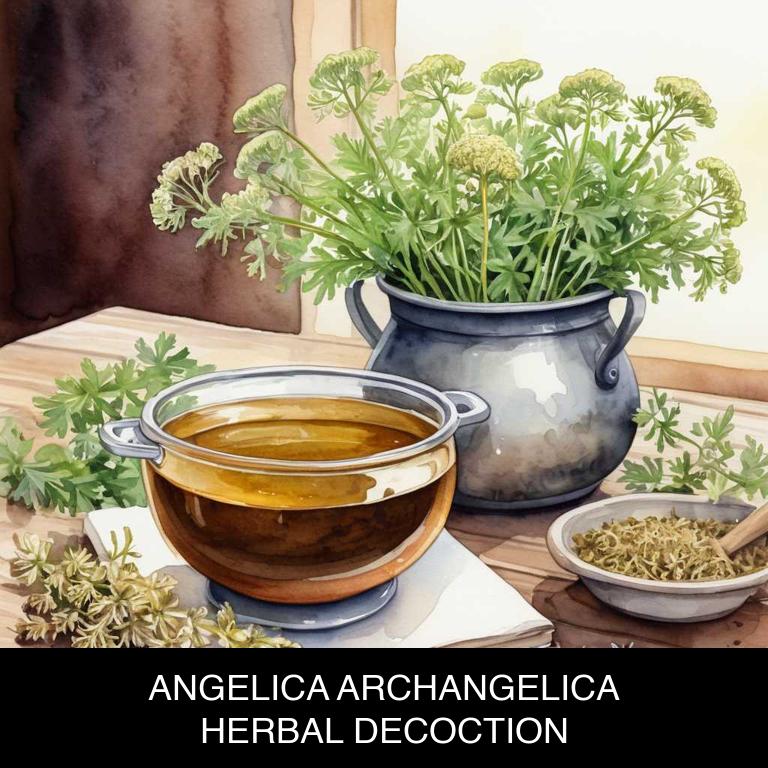
Medicinal Constituents
The list below shows the primary medicinal constituents in Angelica archangelica decoctions that help with amenorrhea.
- Falcarinol: A sesquiterpene, falcarinol has been shown to have estrogenic activity, which may help regulate menstrual cycles and alleviate amenorrhea.
- Falcarindiol: Similar to falcarinol, falcarindiol is also a sesquiterpene with estrogenic properties, which may help stimulate menstrual bleeding and alleviate amenorrhea.
- Phenolic acids: These compounds have been shown to have antioxidant and anti-inflammatory properties, which may help regulate hormonal imbalances and alleviate menstrual irregularities associated with amenorrhea.
Parts Used
The list below shows the primary parts of angelica used to make decoctions for amenorrhea.
- Roots: These are used for their high concentration of angelica's medicinal properties, which are believed to stimulate menstrual flow and help alleviate amenorrhea.
- Leaves: They are used in decoctions for amenorrhea due to their high content of volatile oils, which may help to regulate hormonal balance and stimulate menstrual cycles.
- Barks: The barks of the angelica plant are used to make decoctions for amenorrhea, as they are rich in saponins, which may help to stimulate uterine contractions and promote menstrual flow.
Quick Recipe
The following recipe gives a procedure to make a basic angelica for amenorrhea.
- Harvest fresh or dried roots and rhizomes of angelica archangelica in late summer or early fall.
- Chop 1 to 2 teaspoons of fresh angelica archangelica root or 1 to 2 tablespoons of dried root into small pieces.
- Combine chopped root with 8 ounces of boiling water in a heat-resistant glass or ceramic container.
- Steep the mixture for 5 to 10 minutes to allow the root's medicinal properties to infuse into the water.
- Strain the liquid through a cheesecloth or a fine-mesh sieve into a cup or teapot to remove the solids.
3. Ginkgo biloba
Maidenhair tree decoctions helps with amenorrhea because it has a profound impact on the female reproductive system.
The decoction is rich in antioxidants, flavonoids, and saponins, which collectively help to stimulate uterine contractions, regulate hormonal imbalances, and increase blood flow to the pelvic region.
This natural remedy can effectively address underlying causes of amenorrhea such as hormonal disorders, stress, and poor circulation, ultimately promoting regular menstrual cycles and alleviating symptoms associated with this condition.

Medicinal Constituents
The list below shows the primary medicinal constituents in Ginkgo biloba decoctions that help with amenorrhea.
- Bilobalide: Acts as a hormone regulator, helping to restore normal menstrual cycles by modulating the body's hormonal balance and improving endometrial receptivity.
- Ginkgolides: Exhibits anti-inflammatory and antioxidant properties, which can help alleviate the hormonal imbalances and oxidative stress associated with amenorrhea, promoting a favorable environment for menstrual cycle regulation.
- Flavonoids: Possesses estrogen-like properties, which can help regulate menstrual cycles and alleviate symptoms of amenorrhea by promoting the growth and development of the endometrium.
Parts Used
The list below shows the primary parts of maidenhair tree used to make decoctions for amenorrhea.
- Leaves: The leaves of Ginkgo biloba are commonly used due to their high flavonoid and terpenoid content, which is believed to stimulate menstrual flow and alleviate symptoms associated with amenorrhea.
- Seeds: Ginkgo biloba seeds are often employed in traditional medicine for their potential to regulate menstrual cycles and stimulate ovulation, which can help treat amenorrhea.
- Barks: The barks of Ginkgo biloba are also used in decoctions for treating amenorrhea, possibly due to their mild estrogenic properties that can help regulate the menstrual cycle.
Quick Recipe
The following recipe gives a procedure to make a basic maidenhair tree for amenorrhea.
- Measure out 2-4 teaspoons of dried ginkgo biloba leaves and place them in a clean glass container.
- Combine the measured ginkgo biloba with 2 cups of boiling water in a heat-resistant glass or ceramic cup.
- Allow the mixture to steep for 10-15 minutes or until the liquid has cooled to room temperature.
- Strain the decoction using a fine-mesh sieve or cheesecloth to remove the solids.
- Transfer the strained decoction to a glass bottle and store it in the refrigerator for up to 3 days.
4. Dysosma pleiantha
Chinese mayapple decoctions helps with amenorrhea because they contain bioactive compounds that stimulate uterine contractions, promote blood flow to the pelvic area, and regulate hormonal imbalances.
The decoction's primary active compound, podophyllotoxin, has been shown to increase estrogen levels and improve ovarian function, which can help induce menstruation in women with amenorrhea.
Additionally, mayapple's anti-inflammatory properties can help alleviate uterine inflammation and scar tissue that may contribute to amenorrhea.
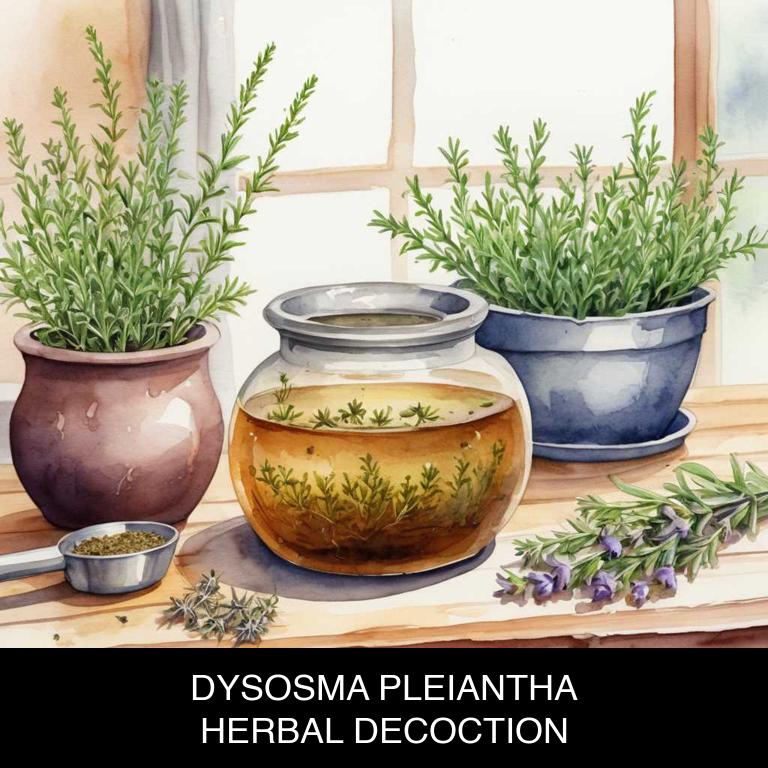
Medicinal Constituents
The list below shows the primary medicinal constituents in Dysosma pleiantha decoctions that help with amenorrhea.
- Phenolic acids: They help with amenorrhea by regulating the menstrual cycle and improving blood flow to the uterus.
- Isoflavones: They help with amenorrhea by stimulating the endometrium, promoting estrogen production, and regulating the menstrual cycle.
- Flavonoids: They help with amenorrhea by reducing oxidative stress, promoting blood flow to the uterus, and regulating the menstrual cycle.
Parts Used
The list below shows the primary parts of chinese mayapple used to make decoctions for amenorrhea.
- Roots: Used for their warming, stimulating properties to promote blood flow and menstrual regularity.
- Rhyzomes: Used for their cooling, soothing properties to calm the uterus and regulate menstrual cycles.
- Leaves: Used for their sweet, astringent properties to balance the body's energy and promote menstrual flow.
Quick Recipe
The following recipe gives a procedure to make a basic chinese mayapple for amenorrhea.
- Gather 15-30g of dried dysosma pleiantha roots and stems from a trusted source.
- Cut the herbs into smaller pieces to increase their surface area for infusion.
- Boil 2 cups of water in a pot for 5 minutes to prepare the water for infusion.
- Steep the herb pieces in the boiling water for 10-15 minutes to release their properties.
- Strain the liquid through a fine-mesh sieve into a cup to separate the solids from the liquid.
5. Rubus idaeus
Raspberry decoctions helps with amenorrhea because they contain a unique combination of phytochemicals, particularly anthocyanins, ellagic acid, and vitamin C. These compounds have been shown to stimulate uterine contractions, improve blood flow to the uterus, and enhance hormonal balance.
By regulating these physiological processes, herbal raspberry decoctions can help alleviate symptoms associated with amenorrhea, such as delayed or absent menstruation, cramps, and mood changes.
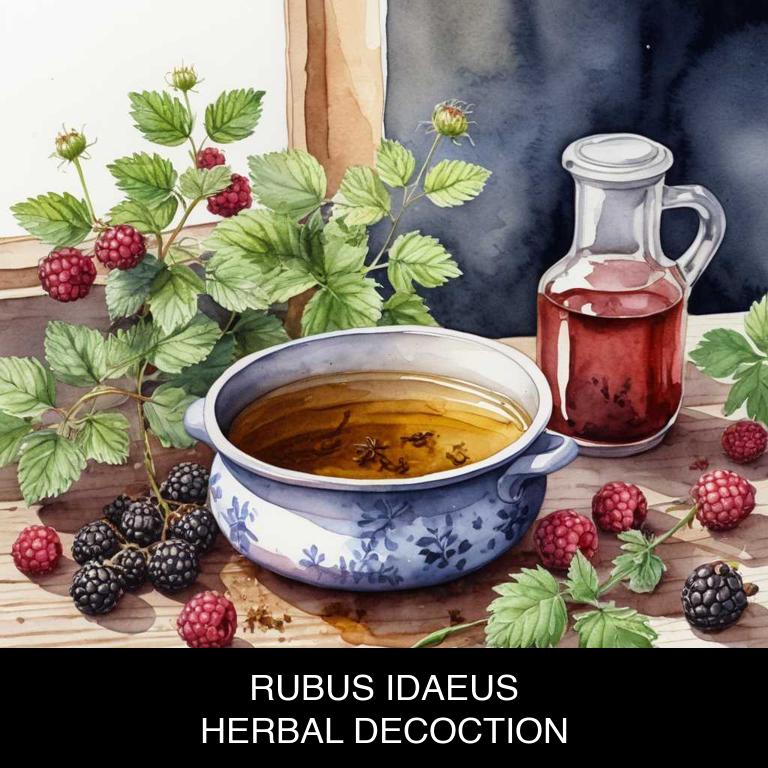
Medicinal Constituents
The list below shows the primary medicinal constituents in Rubus idaeus decoctions that help with amenorrhea.
- Ellagic acid: This phenolic compound has been shown to have estrogenic activity, helping to regulate menstrual cycles and alleviate symptoms of amenorrhea.
- Quercetin: A flavonoid with anti-inflammatory properties, quercetin may help to reduce inflammation and promote uterine contractions, which can aid in regulating menstrual cycles.
- Kaempferol: This flavonoid has been found to have estrogen-modulating effects, which may help to restore normal menstrual function in individuals experiencing amenorrhea.
Parts Used
The list below shows the primary parts of raspberry used to make decoctions for amenorrhea.
- Roots: The roots of Rubus idaeus are used to make decoctions for amenorrhea because they contain emmenagogic properties that stimulate menstrual flow.
- Leaves: The leaves of Rubus idaeus are used to make decoctions for amenorrhea because they are rich in estrogenic and progestogenic compounds that help regulate the menstrual cycle.
- Barks: The barks of Rubus idaeus are used to make decoctions for amenorrhea because they contain stimulant and emmenagogic properties that help to induce menstrual flow.
Quick Recipe
The following recipe gives a procedure to make a basic raspberry for amenorrhea.
- Gather 1-2 cups of fresh or dried rubus idaeus leaves and flowers for the decoction.
- Rinse the rubus idaeus leaves and flowers with cold water to remove any dirt or debris.
- Combine the cleaned rubus idaeus leaves and flowers with 2 cups of water in a saucepan.
- Bring the mixture to a boil and then reduce the heat to a simmer for 10-15 minutes.
- Strain the decoction through a cheesecloth or fine-mesh sieve into a clean container.
6. Cnidium monnieri
Monk's pepper decoctions helps with amenorrhea because it stimulates uterine contractions, promoting regular menstrual cycles.
The decoction's bioactive compounds, such as caryophyllene and eugenol, have a synergistic effect on the uterus, enhancing its function and improving hormonal balance. Additionally, monk's pepper has anti-inflammatory properties that may help reduce pelvic congestion and cramping associated with amenorrhea.
By promoting uterine health and regulating menstrual cycles, monk's pepper decoctions can be an effective natural remedy for managing amenorrhea.
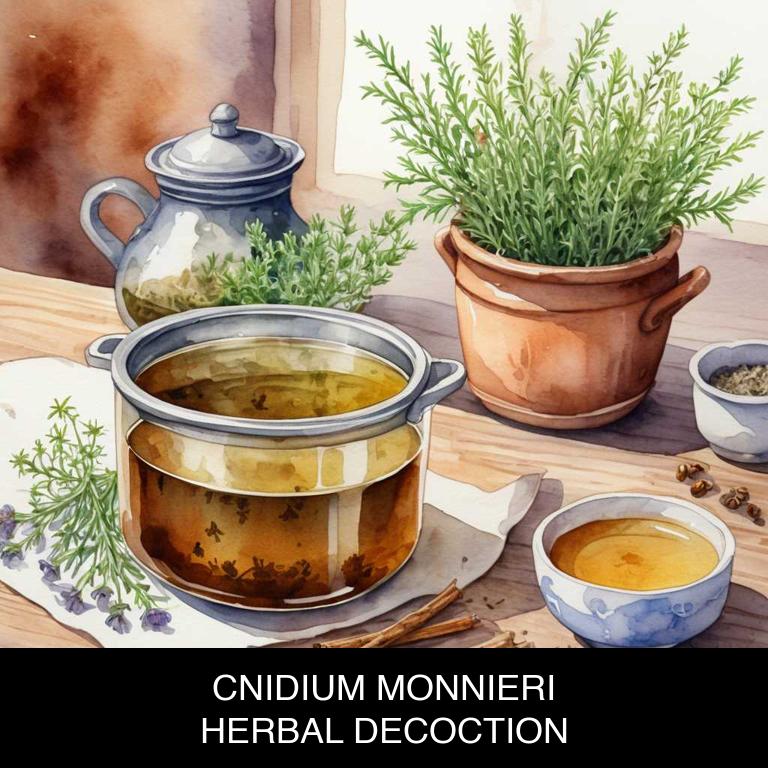
Medicinal Constituents
The list below shows the primary medicinal constituents in Cnidium monnieri decoctions that help with amenorrhea.
- Lignans: Lignans help with amenorrhea by regulating estrogen levels and promoting uterine contractions, thereby inducing menstrual cycles.
- Coumarins: Coumarins, specifically cnidilin and 4,7-dihydroxy-1-methoxy-isocoumarin, have been shown to have estrogenic activity, which can help stimulate menstrual cycles and alleviate amenorrhea.
- Phenylpropanoids: Phenylpropanoids, including ferulic acid and sinapic acid, have antioxidant and anti-inflammatory properties that may help regulate menstrual cycles and alleviate symptoms associated with amenorrhea.
Parts Used
The list below shows the primary parts of monk's pepper used to make decoctions for amenorrhea.
- Roots: Rich in compounds that help stimulate uterine contractions and menstrual flow.
- Leaves: Contain bioactive compounds that may help regulate menstrual cycles and alleviate menstrual cramps.
- Flowers: May help regulate hormonal imbalances and stimulate menstrual flow due to their rich content of bioactive compounds.
Quick Recipe
The following recipe gives a procedure to make a basic monk's pepper for amenorrhea.
- Gather 10-15 grams of dried cnidium monnieri roots and place them in a heat-resistant container.
- Boil 500ml of water in a saucepan over high heat for 5-7 minutes.
- Add the dried cnidium monnieri roots to the boiling water and steep for 10-15 minutes.
- Strain the liquid mixture through a cheesecloth or fine-mesh sieve into a clean container.
- Discard the solids and store the cnidium monnieri decoction in the refrigerator for up to 3 days.
7. Glycyrrhiza glabra
Licorice decoctions helps with amenorrhea because of its ability to balance the hormonal levels in the body, particularly estrogen and progesterone.
The decoction's active compounds, such as glycyrrhizin and flavonoids, have been shown to stimulate the production of luteinizing hormone, which regulates ovulation and menstruation.
Additionally, licorice root has anti-inflammatory properties that can help soothe the uterus and reduce cramping, making it a natural remedy for addressing amenorrhea caused by hormonal imbalances or uterine issues.

Medicinal Constituents
The list below shows the primary medicinal constituents in Glycyrrhiza glabra decoctions that help with amenorrhea.
- Glycyrrhizin: A triterpenoid saponin, glycyrrhizin has anti-inflammatory and hormonal-balancing properties that help regulate menstrual cycles and alleviate amenorrhea symptoms.
- Isoglycyrrhizic acid: A triterpenoid saponin similar to glycyrrhizin, isoglycyrrhizic acid has been found to stimulate the release of luteinizing hormone (LH), which plays a crucial role in regulating ovulation and menstrual cycles.
- Licoricidin: A flavonoid glycoside, licoricidin has been found to have anti-stress and adaptogenic properties that help reduce cortisol levels, which can contribute to amenorrhea by disrupting hormonal balance and ovulation.
Parts Used
The list below shows the primary parts of licorice used to make decoctions for amenorrhea.
- Roots: They are rich in glycyrrhizin, which helps to stimulate uterine contractions and improve menstrual flow.
- Leaves: They contain flavonoids and phenolic acids that help to regulate hormonal balance and alleviate symptoms of amenorrhea.
- Fruits: They are a good source of phytoestrogens, which can help to stimulate estrogen production and regulate menstrual cycles.
Quick Recipe
The following recipe gives a procedure to make a basic licorice for amenorrhea.
- Gather 1 to 2 teaspoons of dried roots of the plant in question and rinse with clean water.
- Boil 1 cup of water in a saucepan over high heat for 5 to 10 minutes.
- Add the dried roots to the boiling water and reduce heat to a simmer for 10 minutes.
- Strain the liquid through a cheesecloth or a fine-mesh sieve into a clean container to remove solids.
- Discard the solids and store the decoction in the refrigerator for up to 3 days.
8. Paeonia x suffruticosa
Tree peony decoctions helps with amenorrhea because it has been traditionally used to regulate women's menstrual cycles and alleviate symptoms of dysfunctional uterine bleeding.
The herbal formula is thought to warm and nourish the uterus, promoting blood flow and balancing hormones. This can help stimulate menstrual flow in individuals with amenorrhea, particularly those who have experienced irregular or absent periods due to hormonal imbalances or uterine fibroids.
By addressing these underlying issues, tree peony decoctions may help restore normal menstruation patterns.
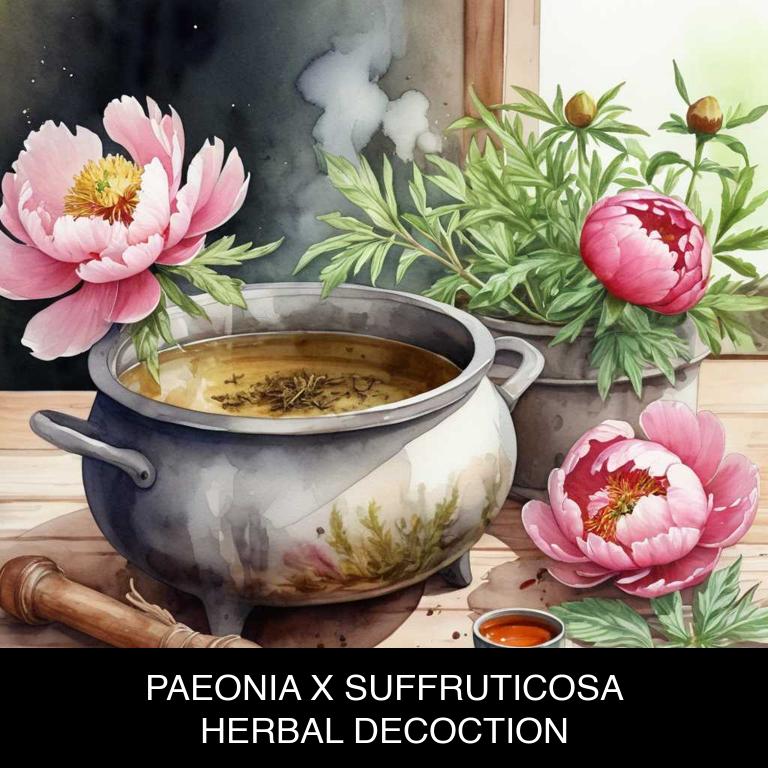
Medicinal Constituents
The list below shows the primary medicinal constituents in Paeonia x suffruticosa decoctions that help with amenorrhea.
- Flavonoids: Flavonoids present in Paeonia x suffruticosa decoctions have anti-inflammatory and antioxidant properties that help regulate menstrual cycles and alleviate amenorrhea symptoms.
- Iridoid glycosides: Iridoid glycosides, such as paeoniflorin, have been shown to have estrogen-like effects and anti-inflammatory properties, which may help regulate the menstrual cycle and alleviate amenorrhea.
- Triterpenoids: Triterpenoids, including paeoniloforin, have been reported to have anti-inflammatory and immunomodulatory effects, which may help regulate the immune system and alleviate amenorrhea symptoms.
Parts Used
The list below shows the primary parts of tree peony used to make decoctions for amenorrhea.
- Roots: They are used due to their rich content of paeoniflorin, an alkaloid believed to have a regulatory effect on menstrual cycles.
- Rhyzomes: They are used due to their ability to stimulate blood flow and relieve menstrual cramps, which may help in regulating menstrual cycles.
- Leaves: They are used due to their potential to stimulate the uterus and regulate menstrual cycles through their rich content of flavonoids and alkaloids.
Quick Recipe
The following recipe gives a procedure to make a basic tree peony for amenorrhea.
- Gather 30-60 grams of dried paeonia x suffruticosa roots and flowers for decoction.
- Chop the paeonia x suffruticosa roots and flowers into small pieces for easier extraction.
- Combine the chopped paeonia x suffruticosa with 2-3 liters of water in a saucepan.
- Boil the mixture for 10-30 minutes or until the liquid has reduced slightly.
- Strain the decoction through a cheesecloth or fine-mesh sieve into a clean container.
9. Agrimonia eupatoria
Agrimony decoctions helps with amenorrhea because it is rich in anthraquinones, which have been traditionally used to stimulate menstrual flow and alleviate menstrual cramps.
The decoction's bitter compounds also help to regulate the digestive system, reducing inflammation and improving hormonal balance.
By soothing the uterine lining and promoting healthy circulation, agrimony decoctions can help to restore normal menstruation patterns in individuals with amenorrhea, promoting a sense of balance and well-being.
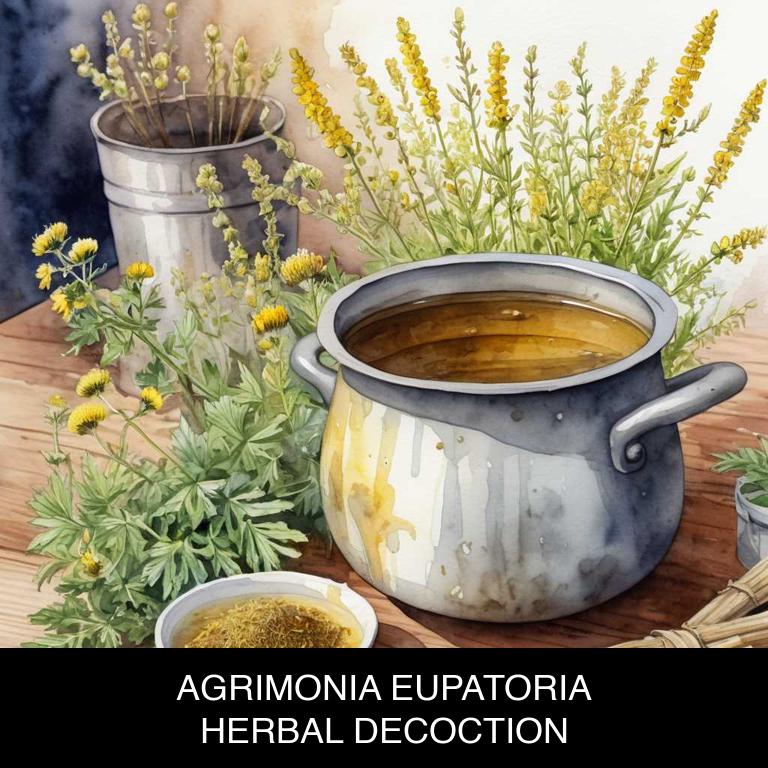
Medicinal Constituents
The list below shows the primary medicinal constituents in Agrimonia eupatoria decoctions that help with amenorrhea.
- Flavonoids: These compounds help with amenorrhea by modulating the body's hormonal balance, particularly estrogen, which is often disrupted in cases of amenorrhea.
- Phenolic acids: These compounds have anti-inflammatory and antioxidant properties, which can help regulate menstrual cycles and alleviate conditions that may lead to amenorrhea, such as polycystic ovary syndrome (PCOS).
- Triterpenoids: These compounds have anti-inflammatory and uterine-stimulating effects, which can help regulate menstrual cycles, reduce uterine spasms, and improve blood flow to the uterus, all of which can help alleviate amenorrhea.
Parts Used
The list below shows the primary parts of agrimony used to make decoctions for amenorrhea.
- Leaves: They are used to make decoctions due to their high content of flavonoids and phenolic acids, which have been shown to have estrogenic properties and regulate menstrual cycles.
- Stems: The stems contain bioactive compounds that have anti-inflammatory and antispasmodic effects, helping to alleviate menstrual cramps and regulating menstrual flow.
- Roots: Roots are used in decoctions to take advantage of their rich content of saponins, flavonoids, and phenolic acids, which are believed to stimulate uterine contractions and regulate menstrual cycles.
Quick Recipe
The following recipe gives a procedure to make a basic agrimony for amenorrhea.
- Gather agrimonia eupatoria leaves and flowers and clean them thoroughly with cold running water for 5 minutes.
- Measure out 1 to 2 teaspoons of dried or 3 to 4 teaspoons of fresh material and place it in a pot.
- Combine the measured agrimonia eupatoria with 1 quart of water in the pot and bring it to a boil.
- Reduce the heat to a simmer and let the mixture steep for 5 to 10 minutes or until it reaches desired strength.
- Strain the decoction through a cheesecloth or a fine-mesh sieve into a clean container and discard the solids.
10. Taraxacum mongolicum
Mongolian dandelion decoctions helps with amenorrhea because they stimulate the liver and gallbladder to enhance hormone regulation, particularly estrogen and progesterone.
The decoction's diuretic properties help eliminate excess toxins and hormones that can disrupt menstrual cycles, while its anti-inflammatory effects soothe the uterine lining, promoting a healthy endometrium.
Additionally, the herb's antioxidant properties help balance hormonal imbalances, leading to regular menstrual cycles and alleviated symptoms of amenorrhea.
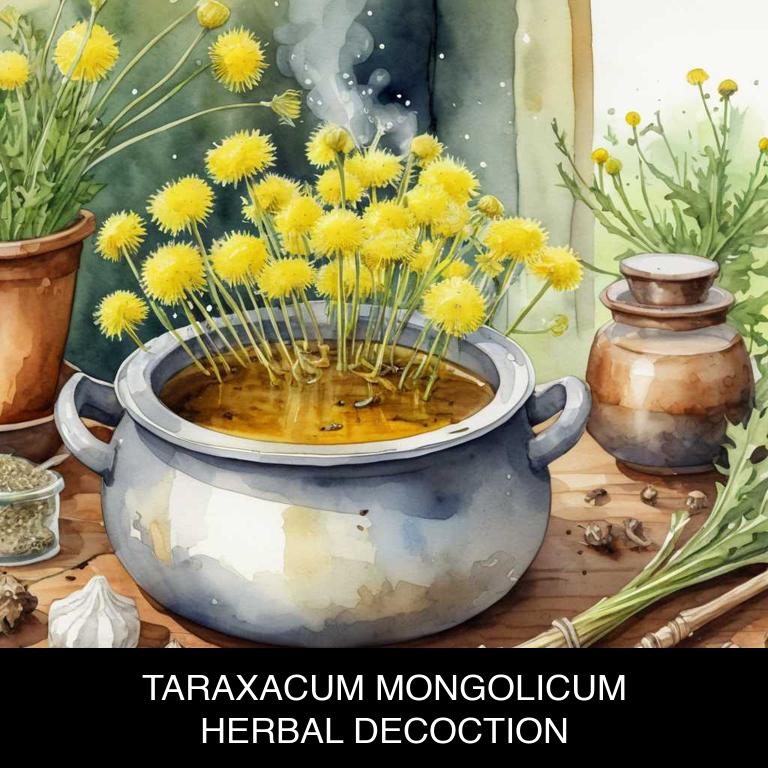
Medicinal Constituents
The list below shows the primary medicinal constituents in Taraxacum mongolicum decoctions that help with amenorrhea.
- Flavonoids: These plant compounds help with amenorrhea by exerting estrogenic and antioxidant effects, which can regulate menstrual cycles and reduce oxidative stress.
- Terpenoids: Terpenoids, specifically those with anti-inflammatory properties, may help alleviate amenorrhea symptoms by reducing inflammation and promoting hormonal balance in the reproductive system.
- Phenolic acids: Phenolic acids, such as ferulic acid, may contribute to the treatment of amenorrhea by modulating hormonal activity and improving uterine health, thus promoting regular menstrual cycles.
Parts Used
The list below shows the primary parts of mongolian dandelion used to make decoctions for amenorrhea.
- Roots: They are used to stimulate menstrual flow and regulate the menstrual cycle due to their high concentration of bioactive compounds.
- Leaves: They are used to regulate hormonal balance and stimulate the uterus, thereby promoting menstrual flow and relieving amenorrhea symptoms.
- Flowers: They are used to warm the uterus and stimulate menstrual flow, thereby relieving amenorrhea symptoms and promoting menstrual regularity.
Quick Recipe
The following recipe gives a procedure to make a basic mongolian dandelion for amenorrhea.
- Harvest 10-15 fresh leaves of taraxacum mongolicum at dawn when the plant is at its peak potency.
- Wash the harvested leaves with cold water to remove any dirt or debris.
- Steep 1-2 teaspoons of taraxacum mongolicum leaves in 250ml of boiling water for 5-7 minutes.
- Strain the decoction through a cheesecloth or a fine-mesh sieve to remove the solids.
- Store the decoction in the refrigerator for up to 24 hours before consumption.
What is the best combination of herbal decoctions to use for amenorrhea?
The best combination of herbal decoctions that help with amenorrhea is a blend of Red Clover, Black Cohosh, and Vitex.
Red Clover contains isoflavones that mimic estrogen, supporting hormonal balance. Black Cohosh helps regulate menstrual cycles and alleviate symptoms associated with hormonal imbalances.
Vitex, also known as Chasteberry, stimulates the pituitary gland to release hormones that regulate menstruation. Drinking a decoction of these herbs, ideally in a ratio of 2:1:1, may help restore menstrual cycles and alleviate symptoms of amenorrhea.
Consult a healthcare professional before using herbal remedies.
What ailments similar to amenorrhea are treated with herbal decoctions?
Ailments similar to amenorrhea/decoctions.html">amenorrhea/decoctions.html">amenorrhea that are treated with herbal decoctions are dysmenorrhea, menorrhagia, and polycystic ovary syndrome (PCOS).
Decoctions made from herbs such as turmeric, ginger, and cinnamon can help alleviate symptoms of dysmenorrhea, while those containing raspberry leaf and shepherd's purse may help regulate heavy menstrual bleeding in menorrhagia.
Additionally, herbal decoctions made with chasteberry and dandelion root have been traditionally used to address hormonal imbalances associated with PCOS.